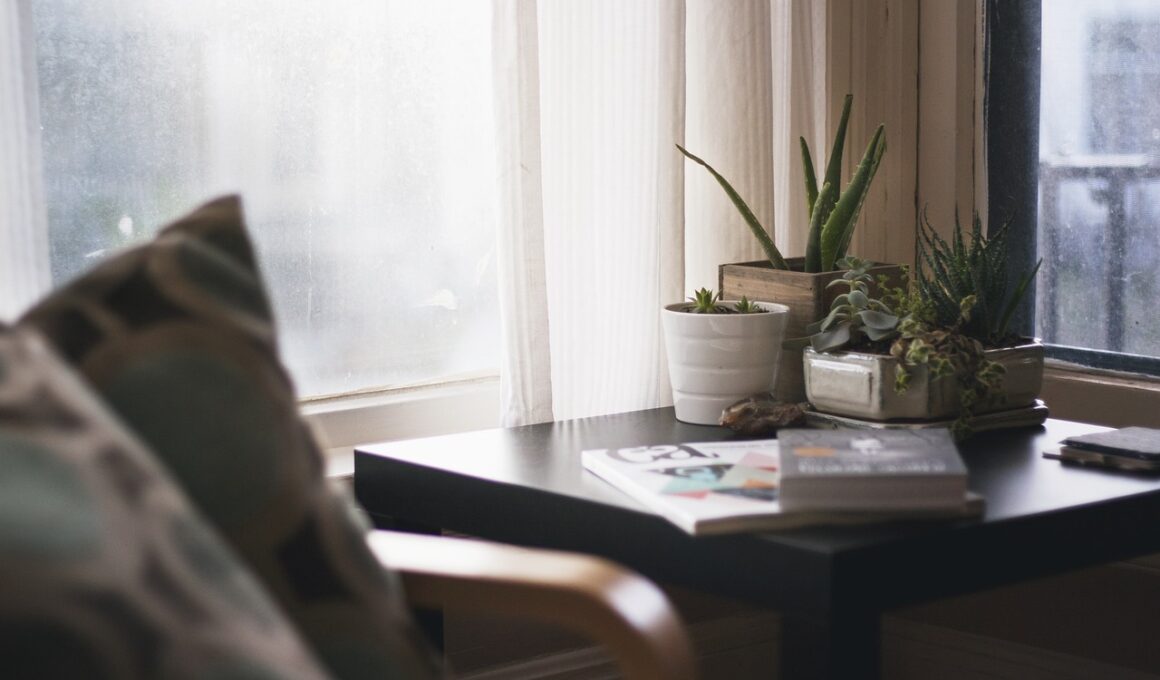How to Use Plants to Improve Bedroom Air Quality and Sleep
Creating a sleep-friendly bedroom environment involves many factors, and one effective method is incorporating plants. Not only are plants visually appealing, but they also provide a natural way to enhance indoor air quality. Some plants are particularly excellent for purifying the air, making them ideal companions for a good night’s sleep. Consider adding plants like the Snake Plant, known for its air-purifying qualities and minimal light requirements. Another great option is the Peace Lily; it thrives in low light and can absorb moisture from the air, potentially reducing mold growth. The Spider Plant is also a favorite, as it effectively removes formaldehyde from the air. When you introduce these plants, make sure to also consider their placement. Position them near windows to ensure they receive adequate sunlight. Additionally, grouping several plants together can create a small indoor garden, maximizing their air-purifying abilities. This imaginative approach transforms your space into a lush, serene refuge that promotes relaxation and restful sleep. Always ensure any plants you choose are non-toxic, especially if you have pets or children at home.
As you continue to explore the benefits of plants, think about the types you will choose and their care routines. Some plants require more attention than others, so selecting low-maintenance varieties is crucial for consistency. The ZZ Plant is excellent for beginners due to its drought tolerance and resilience. Consider plants that guide air purification efficiently while also adding greenery to the room. The Bamboo Palm is another excellent choice; it thrives well in indirect light and can filter various toxins. To ensure they flourish, use well-draining pots and provide adequate drainage to prevent excess water that can damage roots. Furthermore, don’t forget to periodically dust the leaves, as dust buildup can lower their effectiveness in filtering air. Alongside their health benefits, plants also contribute to a calming atmosphere, thanks to their natural fragrances. Having a few strategically placed specimens can also foster a sense of connection with nature, enhancing your overall well-being. Incorporating plants may also invite creativity and inspiration within your personal space.
Choosing the Right Plants for Your Space
The importance of choosing the right plants for your bedroom cannot be overstated. When selecting plants, consider the lighting conditions of your space. Some plants thrive in bright sunlight, while others prefer indirect light or shade. Assess the amount of natural light your bedroom receives throughout the day. For instance, if your bedroom lacks sunlight, opt for shade-loving plants like the Peace Lily or Pothos, which continue to grow in low-light conditions. Alternatively, if your room has ample light, succulents or cacti could be excellent additions. In terms of sheer aesthetic appeal, larger potted plants like Fiddle Leaf Figs can elevate your space, adding height and vibrant green leaves that can enliven the environment. Besides aesthetics and light conditions, consider your emotional association with plants. Having greenery that appeals to you and your personal tastes will enhance your living space further. Also, remember that certain scents can create a calming atmosphere, which is beneficial for sleep. By carefully choosing plants suited to your unique conditions, you can create a personal oasis conducive to deep relaxation and restful nights.
Air Quality and Sleep
Air quality plays a significant role in sleep quality, often taken for granted. Poor air quality can lead to discomfort, restlessness, and various health issues, such as allergies or respiratory problems. Plants act as natural air filters, removing harmful pollutants while simultaneously releasing oxygen that improves air quality. Some studies suggest that having house plants in your bedroom can lead to better sleep and overall well-being. Certain plants are exceptionally good at filtering toxins like benzene, formaldehyde, and trichloroethylene, common in household products. For example, English Ivy effectively reduces airborne mold levels and toxins, making it an excellent choice for enhancing your sleep environment. When considering plants, also think about your ongoing maintenance routine. Regularly watering, repotting, and ensuring proper light exposure will ensure your plants thrive and continue to purify your air. Proper care will allow them to fulfill their potential in your proactive approach to creating a healthier bedroom space. With improved air quality, you may experience enhancements in mood, focus during the day, and your overall health.
Moreover, incorporating plants in your bedroom creates a more peaceful environment that encourages relaxation. Furthermore, the aesthetics of plants add a touch of nature that invigorates your living space and acts as a visual reminder of tranquility. This connection to nature can significantly influence mental health, making it an effective aspect of your sleep hygiene routine. As you consider how plants can enhance your bedroom, think about combining various types that meet your needs for both air quality and beauty. For instance, pairing a Snake Plant with a Boston Fern not only looks appealing but also optimizes the air purification process. Creating layers by varying plant heights or using stylish plant stands can further enhance the room’s design and ambiance. Don’t shy away from experimenting with different arrangements until you find something that resonates with you, serving as a personal refuge. By thoughtfully curating your plant selection, you can cultivate a soothing and inviting atmosphere that will support improved sleep.
Maximizing the Benefits of Plants
To truly harness the potential of plants in your bedroom, it’s essential to care for them. While many plants are low maintenance, understanding their specific needs will ensure long-term thriving. For instance, watering schedules will vary; some plants prefer to dry out between watering, while others like consistent moisture. Be sure to research the needs of the plants you select, adapting your routine based on your plants’ characteristics. Observe any changes in color, leaf health, or general appearance, as these can be telltale signs that adjustments are needed. Additionally, consider rotating your plants periodically to ensure even growth, as light exposure varies by side, especially in small spaces. Enhance their benefits by layering plant arrangements or placing them in areas where they receive optimal light while not obstructing pathways. If you have limited floor space, wall-mounted plants or hanging baskets can be delightful alternatives. Enjoying the beauty of plants extends beyond just their looks; their health benefits will touch all aspects of life, positively impacting your sleep, productivity, and mental health.
Finally, embracing plants in your bedroom goes beyond aesthetics; it fundamentally embraces a lifestyle that prioritizes health and wellness. With each plant, you forge a connection with nature, fostering not only an appealing decor but also a soothing sleeping environment. Start with a few manageable plants and build your collection over time. Appreciate the simple joy that comes from nurturing these life forms while noticing their impact on your living environment. By consciously creating a bedroom that promotes sleep and recovery, you set the foundation for a more rejuvenating and restful experience each night. Remember, it’s not just the plants; it’s the change in your surroundings that contributes to relaxation and comfort. Over time, the green life you introduce can dramatically reshape your psychology towards rest. Ultimately, incorporating plants can also inspire mindfulness, encouraging routine pampering for these flora friends. This ritual ensures heightened awareness of your own well-being and the growth in your sleeping sanctuary. Welcome these green companions into your home and experience the profound difference they can make.
Conclusion
In conclusion, improving your sleep environment through plants is a rewarding journey. Investing in plant life not only enhances air quality but emotionally enriches your personal space. By curating the right selection of plants and understanding their care, you can create an oasis that fosters relaxation and rejuvenation. Their natural presence aids in purifying the air, leading to more tranquil sleep. As you explore this avenue, take time to assess your bedroom’s unique characteristics, like the lighting angles and available space, to select plants that fit seamlessly into your life. Whether you go for bold succulents or delicate ferns, every choice contributes to a healthier environment. Ultimately, the right plants will be subtle partners in your journey towards better sleep and recovery. Remember to intertwine plant care with your daily wellness routine, allowing nature to remind you of its nurturing presence. Taking small yet impactful steps will create a symbiotic relationship with your living space that greatly paves the path for a better night’s sleep.


